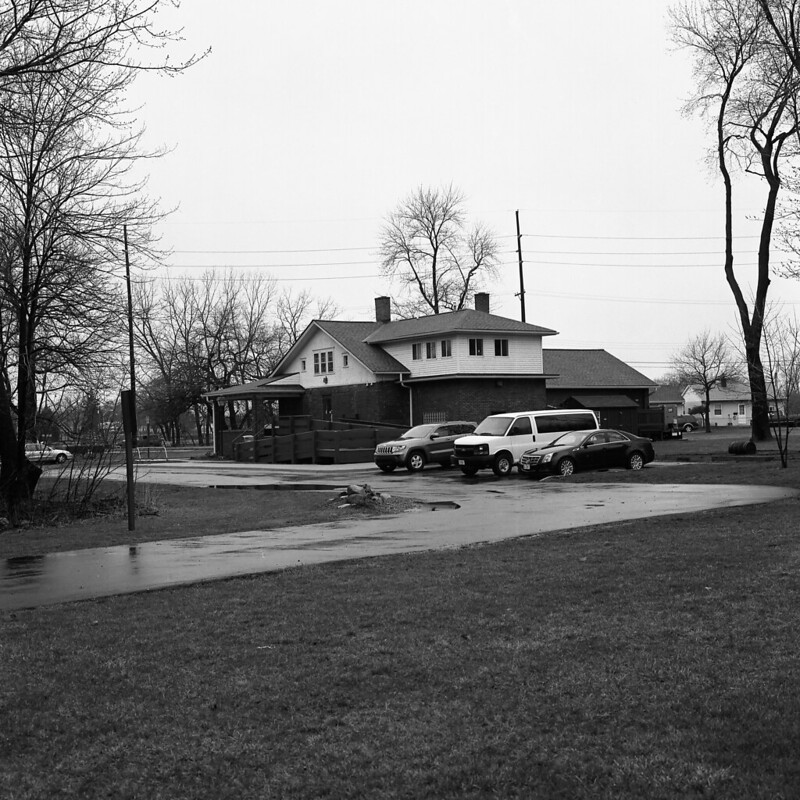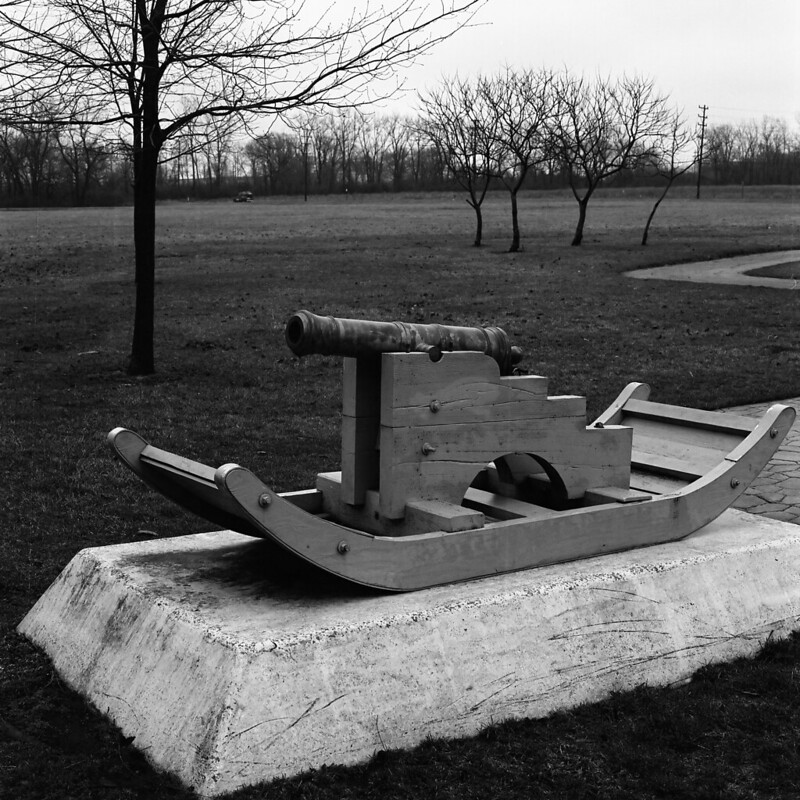After the fall of Detroit to General Brock in the summer of 1812 the British moved quickly to establish a beachhead in the northwest to ensure the security of Upper Canada, and to hold the territory to fulfill a promise to their native allies that it would become their own country at the end of the war (should the British win). The capture of Detroit also put a halt to the planned invasion of Upper Canada from the west. President Madison replaced General Hull as the commander of the Army of the Northwest for the near bloodless capture of Detroit. He first put General Winchester in command, but Winchester was a cautious man and generally not very popular among the troops, in September he replaced Winchester with General William Henry Harrison. Harrison planned to take Detroit in a winter campaign in the early months of 1813. Harrison split the army into two columns, himself taking one column up to Sandusky, while a second column under Winchester was to secure the Maumee Rapids (near modern day Perrysburg, and the site of Fort Meigs). Winchester’s column consisted of 2,000 men mostly untrained regulars from the 19th US Infantry and Kentucky Volunteers (the famous Kentucky Riflemen), a handful of local militia also was a part of the column.

The Visitor’s Centre at the battlefield, go in and watch the presentation on the battle.
Just south of Detroit the small settlement of Frenchtown along the River Raisin had been secured by the British to ensure they had a vanguard should the Americans start to move up Hull’s Road to attempt to take back Detroit in the winter. This old military road still exists today and is known as the Dixie Highway. Procter sent a small group from the Essex militia reinforced with 200 native warriors to secure and hold the settlement. The residents knowing that an American force was nearby sent someone to inform Winchester of this. Winchester was under orders to remain at the Maumee to provide support to Harrison’s column should it be needed, however he went against those orders and sent a detachment of 900 men under Lieutenant Colonel William Lewis to drive the British force out of Frenchtown and secure the area. Upon their arrival on the 18th of January, Colonel Lewis ordered his detachment to charge across the frozen river, the sudden attack and brisk skirmish that followed quickly overwhelmed and drove back the small force that occupied the town. Once secured General Winchester brought the rest of his column north to further secure the town. Harrison over in Sandusky was pleased at Lewis’ action but feared that the British would launch a counterattack quickly and sent a detachment from the 17th US Infantry under Captain Nathanial Hart to further reinforce Frenchtown. Captain Hart found the town in disarray, pickets were few and far between and no major effort had been made to secure the town by January 20th. Winchester was of the opinion that it would take the British several days before the British would do anything, despite warnings that locals has spotted a large British force gathering near Detroit.

Today the battlefield remains preserved, surrounded by the modern city of Monroe, MI. There’s nothing left of the Frenchtown settlement.
Procter was already on the move, after the returning militia who had be chased from Frenchtown on the 18th he began to put together a counterattack at Fort Amhurstburg. He gathered a force of nearly 600 regulars from the 41st and Royal Newfoundland Regiments along with local militia, 800 native warriors under Shawnee Chief Techumseh and three artillery pieces mounted on unique sleds for easier transport in the snow. By the 21st they were within five miles of Frenchtown, and not an American picket in site. As the sun rose on the 22nd the British artillery opened fire upon Frenchtown while the regulars proceeded to line up. Although surprised the artillery bombardment startled the Americans and rose the entire camp in the process. Winchester was also awakened to the artillery fire. Native warriors skirted the settlement to cut off the southern escape route. While they moved they encountered General Winchester and his staff, quickly capturing the general and his aide-du-camp, Major James Overton. Chief Roundhead stripped Winchester of his uniform before bringing him to Procter. The Americans put up a fight but soon both sides began to suffer heavy wounds and casualties. Many of the American troops had not seen any sort of action before this. Many of the militia and regulars laid down arms and attempted to surrender, but the natives without a strong leader (Tecumseh refused to participate) just went on killing the troops even after they had surrendered. It was the resolve of the Kentucky Volunteers that kept the battle going. Procter, now holding Winchester as a prisoner demanded the unconditional surrender of the American forces. Procter played up on the American’s fear of a possible native massacre. Winchester relented and signed a letter of surrender sending it over under a flag of truce with Major Overton. By 11am the fighting had lulled, and the Americans were bolstered with they saw an officer approach under a flag of truce, their elation soon turned to confusion when it was Overton, and he had a letter from Winchester to surrender. Major George Maddison and the Kentuckians refused to surrender and continued the fight, but soon facing dwindling supplies and after assurances that the wounded and prisoners would be cared for issued his own surrender. The battle was over. Procter quickly moved out taking the British wounded and any American prisoner that could walk back to Fort Malden, while leaving the more seriously wounded at Frenchtown under the care of the locals, with the promise that he would send sleds to transport them back. But on the 23rd it wasn’t the sleds that returned. A group of 200 natives looking to avenge their fallen brothers fell upon the town. The remaining prisoners were rounded up, the more seriously wounded were left and the home were set on fire. The entire settlement was destroyed and the prisoners were force marched north, many were killed either by the natives or left to die were they fell.

A replica 3-pound canon mounted on a sled. Frenchtown was the only documented battle that used these sleds for artillery.
The real aftermath of the battle was the effect it had on the American public, the natives, already viewed as savages were now even more so painted in that light. Procter even did not hold the same command and respect that Brock had with Tecumseh. The River Raisin Massacre as it soon became known served as a rallying point for Kentuckians. The US army was soon flooded with Kentucky riflemen ready to avenge their fallen brothers from the Raisin. What was left of Frenchtown continued to be occupied by the British until September 22nd, 1813 when it was liberated by American forces. Those captured remained in British hands until the war ended two years later, including General Winchester. The battle cry of “Remember the Raisin” was heard across the Northwest and during the invasion of upper Canada in September and October of 1813.
Written with Files from:
Guidebook to the Historic Sites of the War of 1812 Second Edition by Gilbert Collins – 2006 The Dundurn Group Publishers
Web: www.riverraisinbattlefield.org/the_battles.htm
Web: www.eighteentwelve.ca/?q=eng/Topic/40
Photos:
Bronica SQ-Ai – Zenzanon-S 80mm 1:2.8 – Kodak Tri-X 400
Dev: Xtol (Stock) 6:15 @ 20C